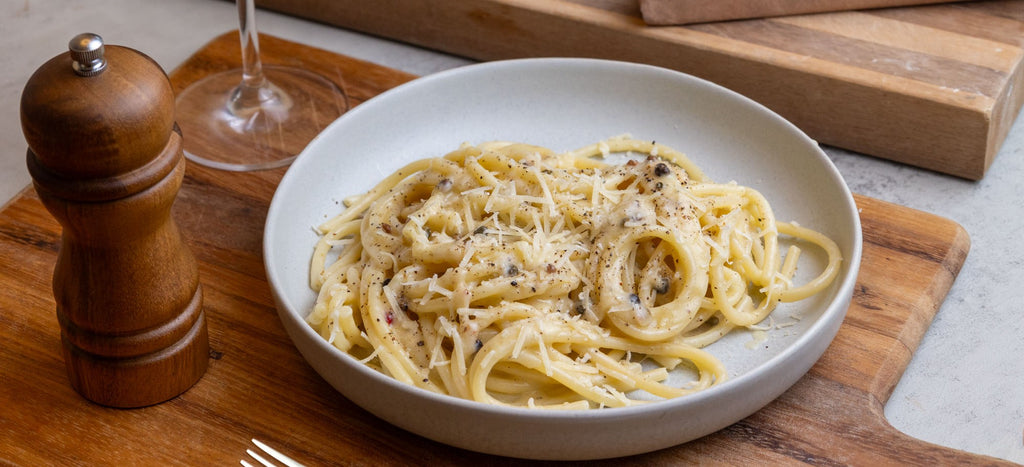Milan might be known for fashion and design, but you can't miss the regional cuisine either!
Milan, the capital of the Lombardy region at the northern edge of Italy, is synonymous with haute couture—it’s home to world-famous fashion brands like Gucci, Prada, and Dolce & Gabbana. Its stylish reputation goes back centuries, following the region’s history as a center of commerce and power. In the Middle Ages, Lombardy’s position at the base of Europe made it a convenient location for trade, and the flow of money and cross-cultural ideas entering the city inspired massive innovations in art and architecture. It was the home of Leonardo da Vinci, and later the base for the dynamic art movement known as futurism. Today, Milan’s grand architecture still draws visitors from around the world; the Duomo, which took six centuries to complete, is a jaw-dropping wonder that must be seen to be believed.
Of course, where’s there’s innovation in Italy, there’s also great food! All that trade and travel brought new and exciting ingredients here from across Europe, Asia, the Middle East, and even the Americas. Saffron, an extremely valuable spice from Spain and the Middle East, came to be so popular here that it became the base of the city’s most famous dish, risotto alla Milanese. The fertile plains of the surrounding Po Valley became Italy’s rice center after the grain traveled here from Asia, making risottos and timbales more popular than pasta. Today, Milanese residents still have a taste for new flavors and avant-garde techniques, and the local culinary scene is always evolving.
If you’re planning a trip to Milan, these are the traditional local delicacies that can’t be missed:

Osso Buco: Consisting of a hefty veal shank braised slowly with local wine and aromatic vegetables, this satisfying dish is a wintertime favorite. In addition to growing rice, the flat plains of the Po Valley make perfect grazing grounds for cattle, and Lombardy has a rich tradition of hearty meat preparations. The name means “bone with a hole” in the local dialect, referring to the way the shank bone is cross-cut to reveal the marrow at its center. That rich marrow contributes an unctuous smoothness to the braising liquid as it cooks, making the dish extra satisfying. You’ll often see this served with risotto alla Milanese for a double-dose of local pride.

Risotto alla Milanese: Milan’s historical wealth gave it both access to ultra-expensive saffron and the desire to flaunt it with this otherwise simple dish made totally luxurious by the addition of the golden spice. Saffron’s rich red threads are the stigma of a variety of crocus known, naturally, as the saffron crocus. Every flower only has three threads of saffron, which have to be harvested by hand—it takes roughly 3,000 flowers to produce just one ounce of saffron! Risotto alla Milanese is still the city’s favorite dish, with creamy rice tinted a gorgeous soft yellow and unmistakably fragrant.

Costoletta alla Milanese: Lombardy shares a border with Switzerland, whose Germanic influence can be felt in this thinly pounded, breaded and fried veal chop reminiscent of schnitzel. Today, you’ll also see pork and chicken cutlets prepared in the Milanese style, always served with a wedge of lemon for brightness.

Busecca: The name for this hearty tripe soup is another Germanic relic—butze, the German word for intestines, became italicized to busa. Busecca is true peasant food from the livestock-farming countryside just outside of Milan. While the finest cuts of meat were sold to rich city folk and nobility, offal like tripe was more accessible to those who worked the land, and they made the most of it by stewing it with beans, whatever vegetables were available, broth and a little tomato. It was once so popular that the Milanese people were once jokingly known as Busecconi, or tripe eaters.

Milano-Torino: OK, this one’s a cocktail—but it’s so emblematic of Milan’s rich history of innovation in liqueurs and aperitivi that it bears the city’s name! Consisting of equal parts Milan-made Campari and Turin-made sweet vermouth, the cross-country cocktail was invented at Milan’s Caffe Camparino in the 1860s. While you’ll be hard-pressed to find a “Mi-To” outside of Milan, you’ll definitely recognize it as the precursor to the Negroni, which adds a shot of gin to the balance, and the Americano, which lightens the formula with a spritz of soda water.























0 comments